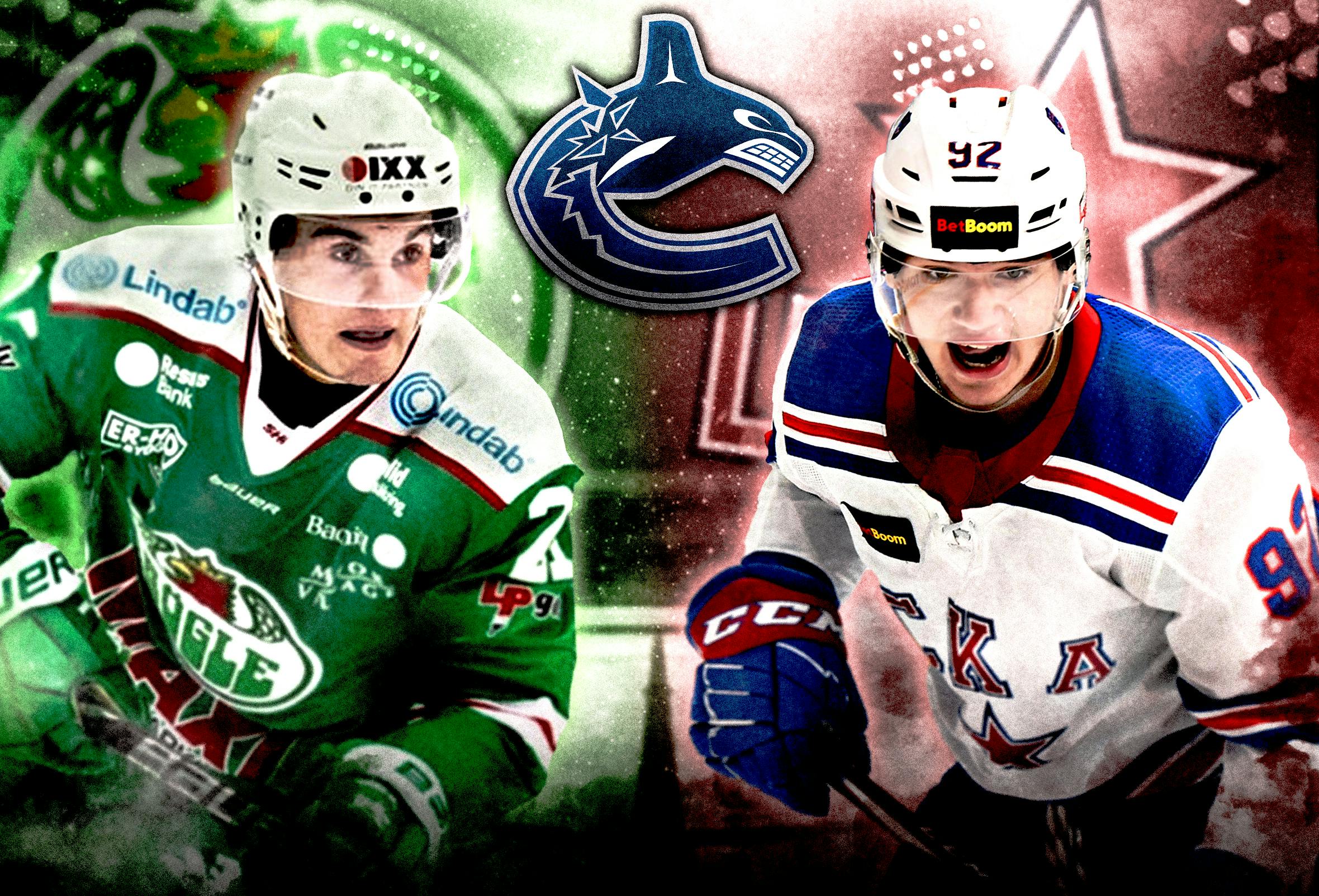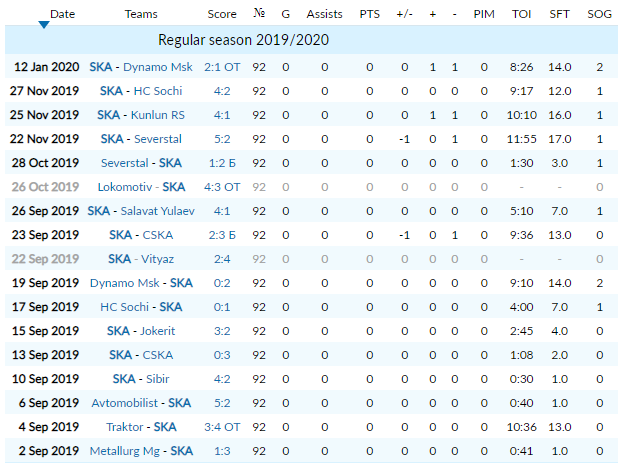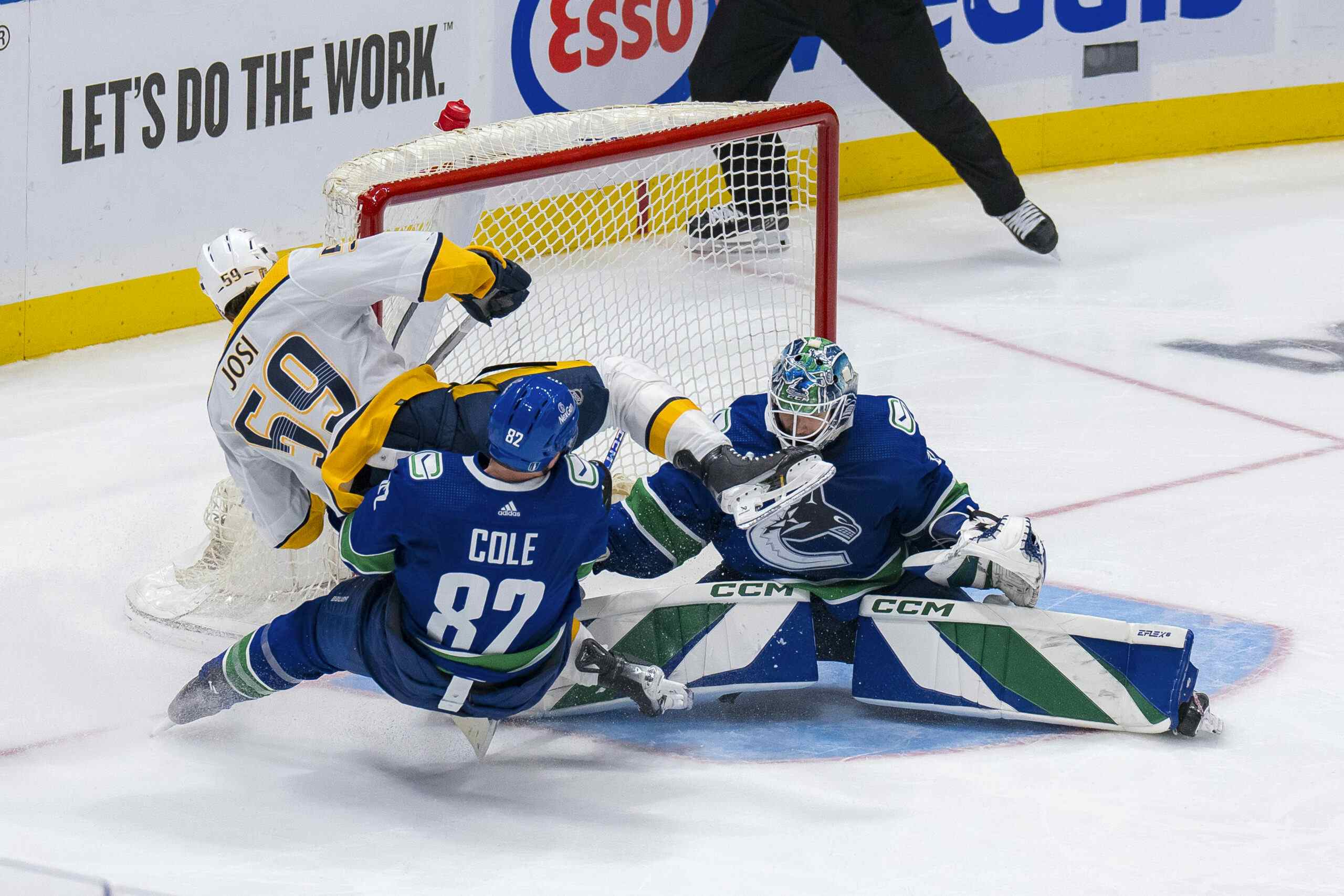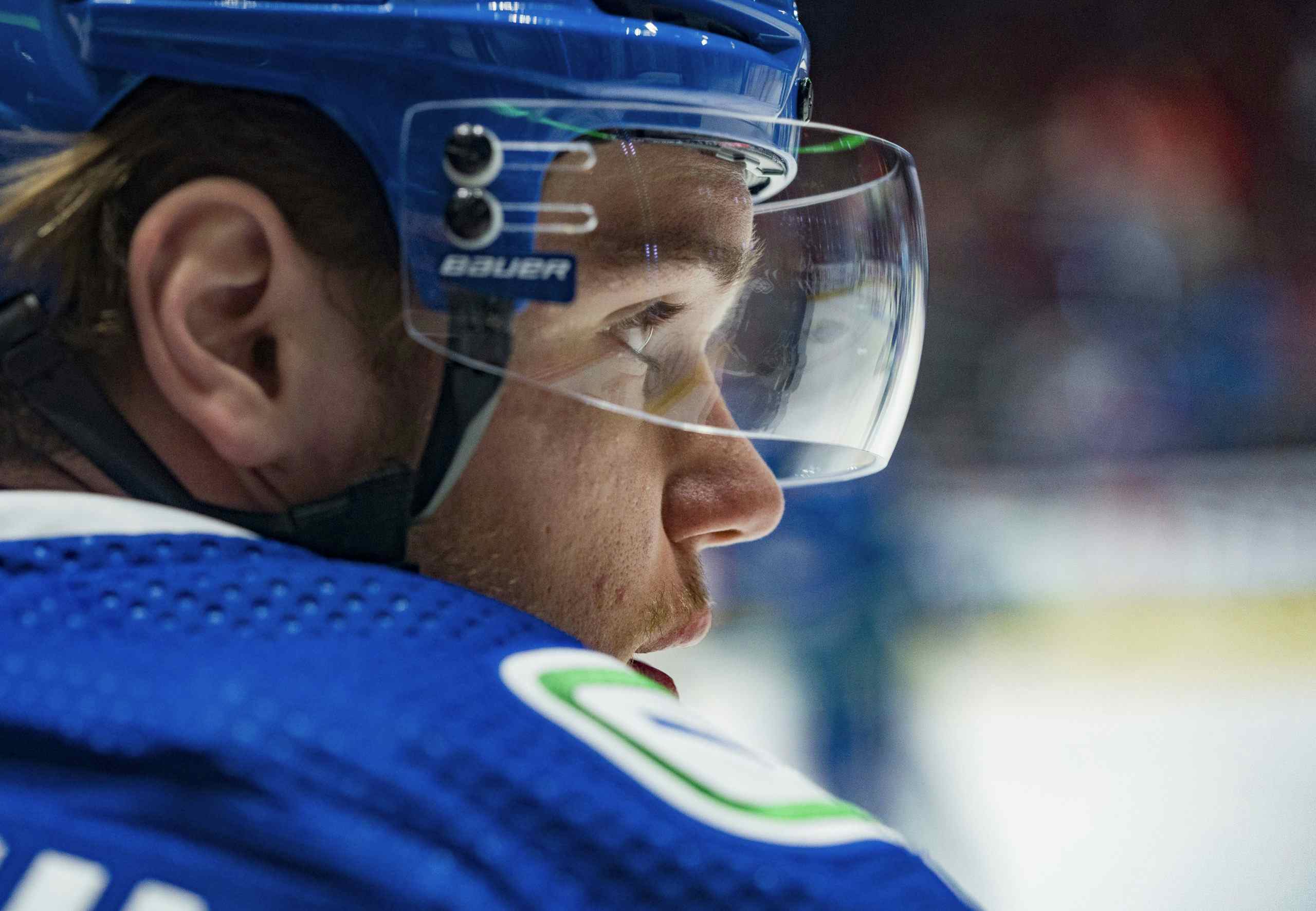Here’s what a breakout season would look like for the Canucks’ top prospects Nils Höglander and Vasili Podkolzin

By Faber
3 years agoThe Canucks have their two top prospects playing overseas in the two most competitive leagues outside of North America.
Vasili Podkolzin and Nils Höglander will each be back with their same clubs as last season and would like to be more impactful players during their draft +2 seasons.
I wanted to look at some comparables to see what kinds of numbers each player would have to put up for them to have breakout years. This would require the player to take a big jump from their production last season and would impact their NHL projections.
I reached out to our own Jeremy Davis and asked if we could work out something new with the pGPS system. I wondered if he could project the success rate as we saw the points per game rise by comparing their potential seasons to other draft +2 players in the SHL and KHL. Jeremy came through once again and the results are extraordinary.
Let’s get into what those seasons could look like.
Nils Höglander
During his 2019-20 season, Höglander was primarily used in a third line role. He saw limited time on the second powerplay unit and with that, he finished the season with nine goals and seven assists in 41 games.
These weren’t numbers that popped off the page but Höglander’s skill shined with his stick skills during the SHL season and was put on full display at the World Junior Championships.
Obviously, Höglander is extremely skilled with the stick and may be the best in the world at completing the lacrosse goal. He will be fun to watch grow as it is astonishing to see a 19-year-old kid pull these type of moves off on the biggest stage he’s ever been on.
That being said, Höglander is much more than just a skills specialist. He is ultra competitive away from the puck and it shows with his aggressive forechecking. He is the right combination of strength and skill on the forecheck and on top of those two things, he possesses the speed needed to be an absolute pest on the forecheck.
Here’s an example of him getting in on the forecheck quick and using his body to gain space for a stick battle that he ultimately wins to gain possession. (Number 21 in white)
This attention to defensive zone awareness is something that he talked about a lot last season during the limited English interviews that Höglander did.
I spoke with him just before the World Juniors and asked about how he works on his defensive game.
“I work with the (Rögle) coaches everyday, we watch all my shifts after the games and watch the defence and what I can do better. I like watching Peter Forsberg, he could do everything with and without the puck. I just want to be good without the puck, I want to be good and be better.”
So what does a breakout season look like for Nils Höglander? That’s why you clicked on this article right?
Well, there are a few comparables for SHL players that have taken a big step in their draft +2 year and then made an instant impact at the NHL level.
One of them is the Columbus Blue Jackets’ 2017 fourth-round pick, Emil Bemström. Bemström did not play in the SHL during his draft +1 year but he did have a breakout season during his draft +2 season.
In that season Bemström tallied 23 goals and 12 assists in 47 games. He added five goals and five assists in 19 playoff games. After that season, he made the jump to the NHL where he appeared in 56 games with the Blue Jackets, scoring 10 goals and adding 10 assists as a very productive player in the Blue Jackets bottom six. He would also get powerplay time with the team, and was effective in that role, adding five goals and three assists on the year.
There are a few other SHL players who had breakout draft +2 years that I researched but I think Bemström is the bar for Nils Höglander to have a breakout season.
There is a big problem with Nils Höglander and the idea of predicting a breakout season for him.
That problem is that he is currently signed with the Vancouver Canucks and is on just a two month loan to his SHL team. That loan expires after his game on December 12th. After that, he will have to make a decision on if he will be finishing his season in the SHL or making the jump over to North America. He could take up to two weeks to make that decision before his team gets back to SHL play on December 26th.
With that, there are a potential 28 regular-season SHL games for Höglander to participate in.
So if he’s going to have a breakout season, it will have to be in those 28 games because if he is ripping up the SHL, the Canucks will likely want to have him continue his ripping up on their roster.
A good bar to set for a breakout season would be having Nils Höglander be a 0.75 point per game player in those 28 games while also scoring double-digit goals. That’s just three points in every four games, and it’s very doable for Höglander.
If Höglander goes off and tallies 12 goals and 10 assists in those 28 games, Canucks fans should prepare for landing. This type of beginning to the season is possible for Höglander. He is getting time on the second powerplay unit and currently getting shifts on the third line with room to move up into the top six if he has a hot start.
As I mentioned earlier, Jeremy Davis made some projections for a 2020-21 season for Höglander’s points per game and this is how it shaped out.

As you can see from the pGPS production spectrum, anything over 0.5 points per game in the SHL during your draft +2 season gives you a good percentage of being an every day NHL player. If Höglander were to break out and get over 0.75%, he is sitting at about a 97.5% chance of being an NHL player while grabbing about 37.5% chance of being a top six type NHLer.
Höglander has been playing at close to a point per game rate during SHL preseason action. Continuing that pace will be a tough task as last year only five players in the SHL were able to finish the season as point per game players (minimum 30 points). This article is about what a breakout season looks like so don’t be let down if Höglander isn’t able to get 0.75 points per game. An ok benchmark for him is likely to be something like 14 points (0.5 ppg) in his first 28 games, that is a decent season start for him.
Be worried if he’s under 10 points at the end of his two month loan.
Vasili Podkolzin
Vasili Podkolzin has been impressing me more and more every single week. Each game he does something that I think would fit in excellent with this Canucks team. He is back for his second full season with SKA Saint Petersburg, playing with two extremely skilled linemates who were both second-round picks in 2018.
The trio of Podkolzin, Ivan Morozov and Kirill Marchenko has looked superb so far in the preseason. They carried that success over into their first regular season game of the year earlier this week. The trio received about 12 minutes of total ice time in the game and during that time controlled a very high percentage of the shot share.
The reason why this trio is so good at controlling the shot share is their ability to dominate the neutral zone — it sort of feels like what the Vegas Golden Knights did to the Canucks in game seven. The trio knocks down pucks, gets sticks in lanes and is exceptional at moving the puck when they have possession.
Podkolzin is the most active of the bunch, consistently bringing an onslaught of pressure while on the forecheck. Podkolzin forechecks with the same effort level as Tyler Motte but is better with his stick, faster and stronger.
There’s a reason why scouts call him a coach’s dream. His effort level is never lacking and that often creates turnovers.
A lot of what will make a breakout season for Podkolzin won’t be measured on the scoresheet. His greatest skill is his motor and that will be tracked from game one to 60 and beyond into the playoffs. We will still look at what kind of a stat line should get Canucks fans’ mouths watering for the day that Podkolzin arrives in Vancouver.
Last season, Podkolzin played in 30 KHL games. Many of those games he was well under 10 minutes of ice time and a handful of those games he was under four minutes of ice time.
This year will be very different and his ice time should be one of the main indicators on if he is having a breakout season. In the regular season opener, he played 12:15 and that number should become the criterion with room for improvement at the season goes on. If Podkolzin gets to something like 15 minutes a night, that will be a good stepping stone for him.
Last year it took until the final 13 games of the season for Podkolzin to begin to average over 10 minutes of ice time in games.
Here are Podkolzin’s first 17 games of the 2019-20 season with SKA.

Podkolzin finished the season with two goals and six assists in 30 games.
A comparable for a breakout season could be Pavel Buchnevich. During his draft plus two season, Buchnevich put up 13 goals and 17 assists in 48 KHL games. This was a big jump for Buchnevich, who only had 18 points in his draft +1 season. During his draft +2 season, he played an average of 16:01 through 48 games.
If Podkolzin were to be able to average 16 minutes of ice time, there is no doubt in my mind that he would be able to put up 30 points in the KHL. Right now Podkolzin is not finding himself on either special team units. This will be a big loss for him in the points department. It means that all of his points will be coming at 5-on-5.
I think there is still a chance for him to slot into the second powerplay unit as the net-front presence, but his coach is currently using his linemate Morozov in that role.
So with all of that taken into account, what does the stat line look like for Podkolzin to have a breakout season?
The first thing I need to see during a breakout season is more ice time. If Podkolzin gets over 15 minutes a game that will be huge for his development.
As for points, he can potentially play 60 KHL games this season.
A breakout season looks something like 17 goals and 18 assists in those 60 games. If he is given powerplay time, you can jump that point total five or so points up to 40 points in 60 games. As I mentioned earlier, Podkolzin’s breakout season isn’t all about points, an ice time jump would be a huge indicator of improvement.
Here’s how Jeremy’s pGPS system values points per game in the KHL during a draft +2 season.

As the pGPS production spectrum indicates; if he is able to get about 35-40 points in 60 games, then he will have a high chance of being a top six player at the NHL level. According to the pGPS, if Podkolzin is able to tally over 0.68 points per game this season he has over 50% odds of being a bonified top six player in the NHL.
Anything over 30 points puts Podkolzin on track to be an immediate impact player at the NHL level.
Both of these players are very capable of accomplishing these breakout seasons. The future is very bright with the current core taking the steps they did in their playoff run. Adding two players of Höglander and Podkolzin’s calibre is going to make a significant improvement to the Canucks’ top nine forward group.
As mentioned in this article, Höglander’s two month loan expires after his team’s game on December 12th. I’ve spoken with his camp and they are saying that a decision on when to come to North America has not been made yet as the 2020-21 NHL season is still a while away and they are happily playing in Sweden for Höglander to develop.
Podkolzin’s situation is a bit different. He will be playing the entirety of the 2020-21 KHL season as he must fulfill his contract with SKA. After his year is complete, he is then able to sign with Vancouver and come play immediately with the Canucks. SKA is a strong team and could go on a deep playoff run in the KHL this season. Their playoffs are set to finish in late April so we will have a fluid arrival date of mid-April to early May for Podkolzin. This could work in the Canucks’ favour with an estimated start for the 2020-21 NHL season being mid-December.
Podkolzin could potentially be a trade deadline type boost to the Canucks bottom six when he is able to come over to North America.
Here at CanucksArmy, we will continue to track these two players as well as other Canucks overseas prospects who have begun or are just about to begin their regular seasons.
Here’s the too long didn’t read version of this article about breakout seasons for Höglander and Podkolzin:
Nils Höglander: 0.75 points per game with double digit goals
Vasili Podkolzin: 0.66 points per game with 15+ minutes of average ice time
Recent articles from Faber





